|
|
|
|||
|
|
||||
|
|
||||
| Smoke Trails | ||||
|
|
HOME | SITE MAP | FORUM | CONTACT |
|
||
|
ABOUT | MOTORS | MODELS | ARCHIVE | HISTORY | STORE | FAQ | LINKS
|
|
|
|
|
|
||||||||||||||||||||||||||||||||||||||||||||||||||||||||||||||||||||||||||||||||||||||||||||||||||||||||||||||||||||||||||
|
Smoke Trails 18
(November 2008)
by Roger Simmonds Adapted from a column originally published in SAM 35 Speaks, November 2008 It is a truth universally acknowledged that if a columnist wants more (or indeed, any) letters and feedback, all he has to do is to make a serious factual error. In discussing the range of vintage Jetex kits produced by A&DB ModelAircraft (Smoke Trails 14, February 2008) I stated that the MiG 15, Sabre, F-86 and Hunter displayed on their website were not Skyleada models, but Keil Kraft designs, and (worse still) that the F-84 Thunderjet was a Veron product. All this is quite wrong, and brought a sharp rebuke from Alan Briggs: “The MiG 15 plan shows the Skyleada logo, and, more pertinently, clearly states ‘Designed & Drawn by Ray Booth’, who I believe was their premier designer. The Thunderjet and Jet Provost plans both have the Skyleada logo but there is no mention of the designer. The F-86 Sabre [right] is similar to the Gnat [see (Jet)X Files 18, June 2004], and can be built as the F-86A, D, or E versions. I have an original and complete kit (below), and no, it isn’t for sale!”  Oh dear! What makes this more embarrassing is that I included the MiG 15, Jet Provost and Thunderjet in my list of Skyleada kits in Now, where was I? Oh yes … in mitigation, the Skyleada MiG 15 has long been cast into the shade by the wonderful Keil Kraft design, and I’m not the only jet jockey for whom the Skyleada F-86 came as a (pleasant) revelation. It may not be a Ray Booth design, but this Sabre is a welcome alternative to Albert Hatfull’s Keil Kraft design, which, though it flies well, is just not accurate enough to satisfy the more obsessional builder. |
 Skyleada F-86 Sabre box art |
||||||||||||||||||||||||||||||||||||||||||||||||||||||||||||||||||||||||||||||||||||||||||||||||||||||||||||||||||||||||||
|
|
|
|||
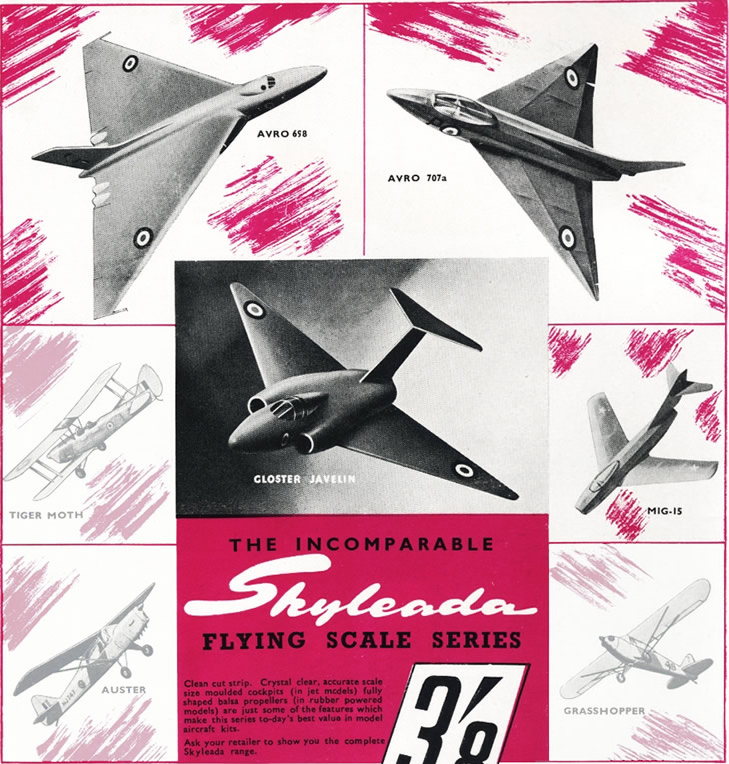 |
||||

Apropos the ‘M.I.G. 15’. in this advertisement from Model Aircraft, April 1953, the Javelin is given pride of place, and the Avros 698 and 707 are both more obvious than the crepuscular MiG 15 which is all but hidden away on the bottom right. A slightly later Skyleada advertisement (Model Aircraft, October 1954), lists the full range of “Flying Scale Star Series” kits “Designed for Jetex 50” as:
Avro 707A, Avro Vulcan, Gloster Javelin, M.I.G. 15 [sic], Hawker Hunter, Supermarine Swift, U.S. Navy Cutlass [right], Thunderjet, Mystère IV [right], Sabre Thanks, Alan. The A&DB website is, then, well worth visiting by all us vintage types. I have heard especially good reports of the FROG replicas and I have seen several flying very well at Old Warden this year in the hands (or rather, out of the hands) of Graham Potter and Mike Stuart. I do not understand the dog-in-the-manger attitude of Amerang and I’m pleased that some manufacturers of vintage kits ignore their threats. The A&DB Javelin and Comet are already available on the website (and from Flitehook), and I hope it will not be too long before they are joined by the others. As I implied earlier, the Skyleada F-86 Sabre looks very tasty, and it is a real pity this design has been even more elusive than their MiG 15. Neither I nor Andy had ever seen the plan, which is distinctly better drawn than the Gnat’s (pace Alan), and it is only recently that Pete Williams got his hands on one. Pete writes: “The Sabre was the only one of the jets I could not find. I had a very poor Nth generation copy of a copy of what must have been a dyeline print. This had so much background as to be virtually unusable. However, last year I bought a lot of Skyleada kits – both rubber scale and Jetex powered models – from a guy in Canada. Amongst them was the Sabre. I’ve not had any demand for it so far.” I hope this article and the plan below (courtesy of Pete) will stimulate interest in this ‘long-lost’ design. I have already put my name down for a kit. |

- Model Aircraft, October 1954
 Skyleada Mystère IV (plan detail) 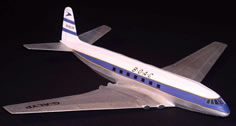 Adam Jenik's 95% reduction of the Skyleada Comet for Jetex 50 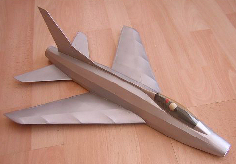 Mike Stuart's build of the Skyleada Super Sabre. Mike says, “As you can see …, this old Skyleada design is not overendowed with stringers, and begs the question, just how many sticks of balsa do you need to reproduce a round fuselage?” |
|||
 The Wilmot Mansour Flying Wing (WM FW) revisited |
||||
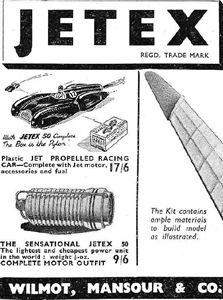
Readers will remember that one of Peter Cock’s first jobs on joining Jetex in 1952 was to ‘proof build’ a kit straight off the assembly line. Even though this was a couple of years into the production run, he still found many errors, some of which were, unfortunately, accurately reproduced in Tony Betts’ POF kit. Peter wonders why there were no letters of complaint, as the kit sold very well. So it was with delight that I learned Steve Bage was interested in this iconic model, and that he had, with his consummate computer-aided design (CAD) skills, cleaned up the original plan and corrected all the errors in the lengths of spars and the positions and subtle angles of the notches. It is these sorts of things, apparently, that CAD can do so well. |
|
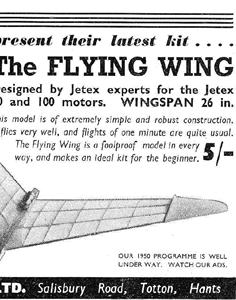
- Model Aircraft, 1950
|
||
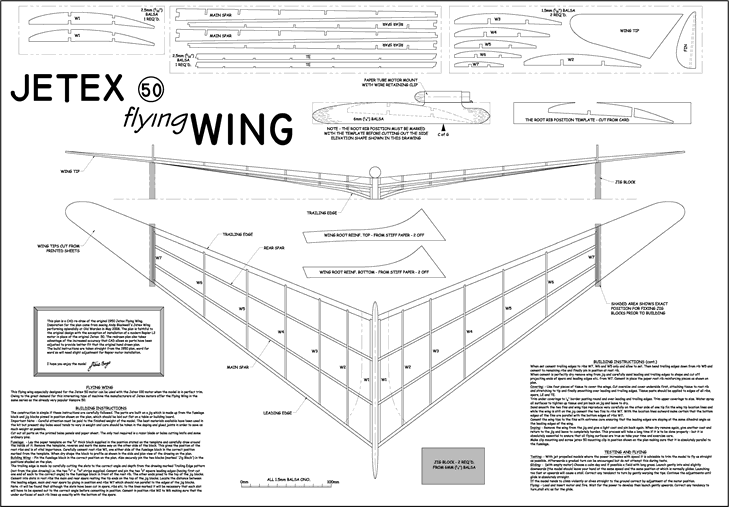 |
||||
|
Both Steve and I have built from this new plan (above), and I can confirm it goes together well, though I found jig building, ‘up in the air’ so to speak, a trifle awkward and I would have much preferred to have built it ‘flat’ on the plan. |
||||

Steve’s model, being lighter, and with the correct undercamber and washout, goes even better and will even climb when powered by a lowly Rapier L-2LT. Steve is obviously quite enchanted with this design – it is so distinctive in the air – and has further plans for it. But before we discuss these, it would be good to pay a small tribute to Harold Figgins (HF) himself, who is something of a ‘forgotten man’ in Jetex history. |
|
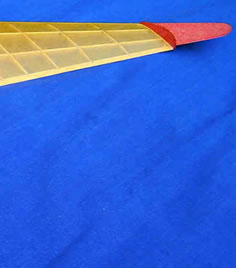
- Roger Simmonds
|
||
HF retained his ‘art student’ image at Jetex, sporting those essential accoutrements of the 50s’ artist – a pipe and a beard. The photos (right) do not reveal if he also wore sandals. Bert remembers he had an ancient car and says he was more of a sculptor than an aeromodeller, which may explain the WM FW’s beautiful lines but idiosyncratic ‘egg crate’ construction.
 It is uncertain if HF designed the Meteor, Vampire and Avro 707B (the advert left, from 1950, is irresistible – oh that the actual model was even half as good-looking as the drawing!). The pictures right, from Model Aircraft, 1950 are, alas, the only ones of Mr Figgins I have been able to find. He was, according to Bert Judge, an “Art Student” and, like Bert, had been with Joe Mansour and Bill Wilmot since their days at FROG. When Joe Mansour and Bill Wilmot left Lines Brothers to set up Jetex, Harold Figgins was the only one of the wartime staff to go with them, though, of course, Bert did join them later.
It is uncertain if HF designed the Meteor, Vampire and Avro 707B (the advert left, from 1950, is irresistible – oh that the actual model was even half as good-looking as the drawing!). The pictures right, from Model Aircraft, 1950 are, alas, the only ones of Mr Figgins I have been able to find. He was, according to Bert Judge, an “Art Student” and, like Bert, had been with Joe Mansour and Bill Wilmot since their days at FROG. When Joe Mansour and Bill Wilmot left Lines Brothers to set up Jetex, Harold Figgins was the only one of the wartime staff to go with them, though, of course, Bert did join them later. Nevertheless, he must have been a competent engineer; helicopters, especially with a six-foot span and powered by two Jetex 350s, cannot have been easy. One wonders is he liaised with Sigurd Isacson, who was also giving impressive demonstrations of large helicopters around this time. Mike Ingram carried on the Jetex tradition of helicopters with great success after HF left Jetex in 1952. It is not known what became of him. |
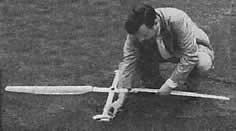 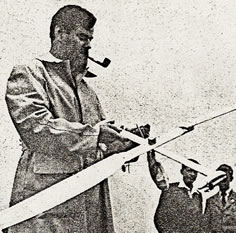 Harold Figgins in the modelling press of 1950. Note the artistic pipe and beard
- Model Aircraft, 1950
|
|||
|
But Harold Figgins’ concept continues to inspire, and, having tidied up the original WM FW plan to his own and others' satisfaction, Steve decided to refine the design further, to give it, in modern parlance, ‘a complete makeover’, and produce a stunner of a model that could be kitted by the estimable Simon Firth’s Bluebottle Squadron. Steve writes: “The new design uses a thinned down (8%) Eppler 325 at the tip which transitions smoothly to the original Simplex 9% section at rib W4. The inner 3 ribs are as HF intended, complete with a ‘flapped’ TE. I also added an extra rib as I found that the LE compressed under tissue tension. I’ve retained the full depth notched spars – I know they leave a bit to be desired structurally, but if built on the jig they are necessary. I changed the fuselage pod from Steve has succeeded admirably The planform is retained, but the clever application of reflexed Eppler aerofoils towards the tips should reduce the drag significantly. And so it proved. Steve reports a 27" version flies with an L-1, and the 18" prototype goes very well indeed with the same batch of motors. Too well, in fact: rather to his surprise, it was actually quite a handful and overpowered! The kit version (right) will therefore be somewhat larger at 20", which is just about right. Curiously, a model very (very) similar to the WM FW was flown by Earl Van Gorder in the US. EVG, as he was known, was well regarded for his Flying Models monthly column in the 50s. After his death this model was kitted by by EasyBuilt (EB), as the ‘EVG Flying Wing’. A close friend of Earl was sure that he didn’t design this model himself: “Earl”, he says, “never designed his own models, he was exclusively a kit/plan builder. If he had designed it himself he would have told him about it, 'rubbed it in' even, as we had a friendly rivalry”. The kit is still available from EB (right). |
 Steve Bage’s prototype Wing-Ding for Rapier L-1. Too small for a typical L-1 at 18” and 6.5g, the span of the kit version (below) is increased to 20" 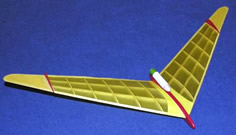 Steve Bage’s Wing-Ding as kitted by the Bluebottle Squadron (UK) 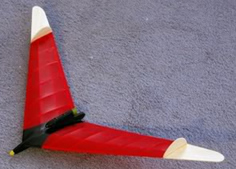 Steve Bage’s Wing-Ding as kitted by Shorty's Basement (USA) |
|||
|
Steve comments: “My theory is that EVG built his wing from the Jetex plan, and after his death EB back-engineered their kit from his model, not realising that it was a Jetex design all along. The EB version differs from the Jetex design in one really quite critical area: the WM FW is very cleverly built over a jig which ensures the correct twist and alignment of the wing ribs is automatically built in, the EVG FW is built conventionally flat on a board. Hence the wing section is flat bottomed and lacks the ‘flaps down’ and wing twist so characteristic of Figgins’ design. As a result the EVG FW will not fly at all unless the winglets are adjusted to a more extreme negative incidence angle than that indicated on the plan.” It’s a pity that EB do not acknowledge their model’s true roots. Ben Nead, who has an EVG FW kit, and an original plan for the WM FW (whose span may be 26" or 27") sums up the story so far: “The [EVG] design has been reproduced by a few different companies, most recently EasyBuilt, who actually only claim it is ‘based on a model built by EVG’. This may explain quite a lot. Whilst it is similar in concept to the Jetex one, it is a different design in some respects. Most notably, the airfoil doesn't have the camber at the wing roots. I'm afraid the kit is a bit of a jumble. As with many swept wing kits, the ribs and spars are cut ‘straight on’ and there is an awkward gap between the rib slots and the wing spar. For a clean join, slots should be cut at the same angle as the spar, but no doubt this would have added to the cost.” To conclude: if one wants an ‘authentic’ WM Flying Wing I can recommend Steve’s plan over the original. The POF kit is no longer available and there are questions against the EVG Flying Wing. But, (and ignoring the philosophical question of how far a design can be ‘made over’ before it ceases to be what it was) the Bluebottle WingDing is now available: it is a nice modern and accurate design, it is beautifully produced, flies splendidly, and deserves to sell like hot cakes. I would advise fitting a dethermaliser. |
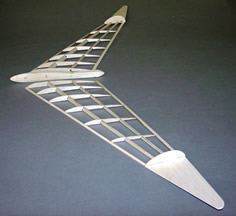 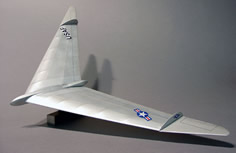 The EB EVG FW. Surely an unacknowledged WM FW ‘clone’? |
|||
|
|
||||
|
|
|
|||
|
|
|
|
|
|
|
|
Acknowledgements - Article: Roger Simmonds - Illustrations: Steve Bage, Andy Blackwell, Carlo Godel, MAAC archives via Bill Henderson, Roger Simmonds, Chris Starleaf, Mike Stuart |
|
|
|
|
ABOUT | MOTORS | MODELS | ARCHIVE | HISTORY | STORE | FAQ | LINKS |
|
|
Terms of Use
|
Queries? Corrections? Additions?
Please
contact us.
|
|